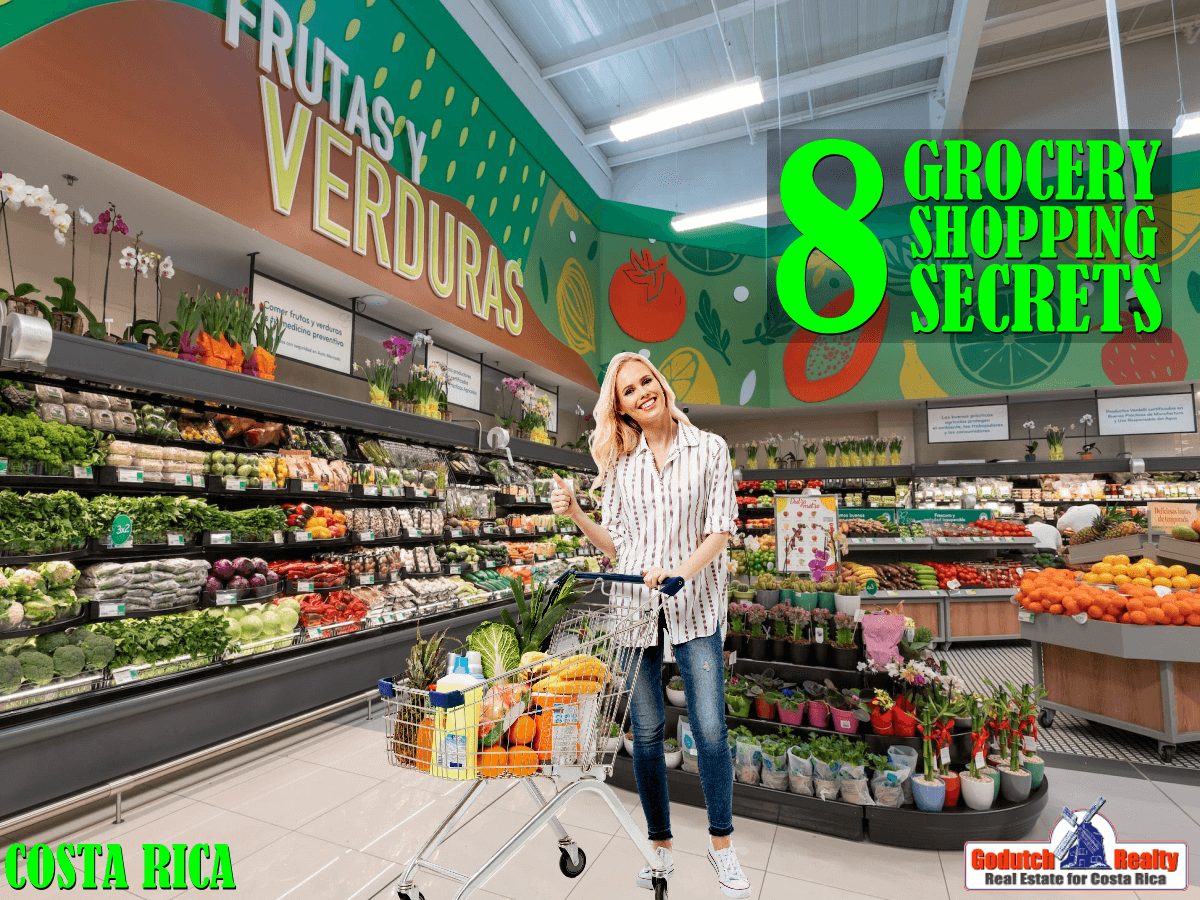Estimated Reading Time: 7 Minutes
I’d like to share 8 Grocery shopping secrets with you. That’s because shopping in another country, like Costa Rica, is a science. In today’s blog, I’d like to give you a hand with your grocery shopping in Costa Rica. You know how to get started and what to look for.
Costa Rica offers a wide range of grocery stores or supermarkets. Buying from a large chain doesn’t necessarily mean you get the best prices.
Most supermarkets in Costa Rica play around with the prices even daily. This is why I want to share these grocery shopping secrets with you. What is cheaper at store XYZ today might be a lot more expensive there the next day. Check prices every time you go grocery shopping. You’ll get the hang of which grocery store is more consistent in its pricing and which changes prices on you all the time. Be aware that most supermarkets often offer unique promotions to stand out from their competitors. While many stores run similar discounts (such as weekly sales or loyalty programs), most chains aim to create distinctive offers that differentiate their brands and attract specific customer segments.
Grocery shopping is a really interesting topic. It’s not only about saving money. It’s also more about knowing what and how to shop. What to look for and what to be aware of. That’s why I’m giving you these grocery shopping secrets as a bonus today.

1. Adjust to the local food culture
Now that you have moved to Costa Rica, will you keep eating the same food as you did back home? Try shopping for local food, go native. You’ll save yourself a lot of money, and you might be in for a great adventure. It’s easy to find recipes online, try it. If you don’t like it, you move on to the next weird product. I don’t like rice and beans myself, but I love lots of other local dishes my wife makes.
2. Shopping for imported products
Imported products from outside Central America are subject to high import taxes.
A can of Planters mixed nuts costs twice as much as a local peanut brand like Mani Pro. Most products made in Central America pay very little import tax, so they are a lot cheaper. Products made in Costa Rica are even cheaper, but check to make sure. Lately, Dos Pinos Milk Products are sold cheaper in Panama and Nicaragua than in Costa Rica. Dos Pinos is the largest local milk factory, but also the most expensive.
Most foreigners just grab the products that they used to buy back home. That habit will double or triple your shopping bill.
You should only purchase those imported products that are not available locally. Turkey filling, for example, or your favorite cornflakes. Costa Rican-grown black pepper costs a lot less than imported black pepper.

3. Labels in English and Spanish
Besides being a great way to learn Spanish, you should only purchase products that carry Spanish-language labels. Because many foreigners live in Costa Rica, you’ll now find many locally made products with labels in both languages, and the back of the label includes information about its origin.
4. Taste and quality of the products
Many products are made differently for each country. A Costa Rican-made peanut butter tastes totally different from a U.S.-made one. Try the locally made product first. Then, if you don’t like it, switch to a different brand.
Most large grocery chains display their fruits and vegetables well. But you can generally purchase your fruits and vegetables much fresher and cheaper at the local farmer’s market, except for some imported products like avocado or apples.
5. Size and packaging
In your mind, 1 pound of coffee should be cheaper than half a pound, right? Sorry, you’re wrong. In Costa Rican stores, most of the time, you’ll pay less for 2 bags of half a pound each. And that’s the case with most products like detergents, pickles, and many others. Always check the different sizes of the products before you purchase.
NEVER assume that the larger size is cheaper.
6. Membership shopping
As for membership shopping, PriceSmart has several stores in Costa Rica. You can compare PriceSmart with Costco or Sam’s Club in the U.S.
Now and then, PriceSmart renews its merchandise, so you won’t always find the same products. They carry an inventory comparable to that of a U.S.-based membership grocery store. They have several locations.

7. Different supermarkets
Costa Rica offers a wide range of supermarkets for your grocery shopping.
- Auto Mercado, choose store location at the top, carries a large inventory of US and European products. So you will have a better chance of finding specialty products like certain spices, turkey fillings, and other typical US and European products.
- Walmart has several supermarkets, each with its own style and products. Walmart itself is very similar to a US Walmart. The smaller version is called Mas por Menos – scroll down for store locations, the very basic grocery store is Pali, and they have a larger version called Maxi Pali
- Other similar-sized grocery stores include Perimercados Supermarkets, which also have Jumbo locations in Alajuela, Moravia, Desamparados, Guadalupe, Liberia, Heredia, and Cartago. You can also order from Perimercados online with Peridomicilios. Mega Super is another large Supermarket chain with many locations, and if you live in Escazu, you might like Saretto.
- In coffee towns like Atenas, Grecia, Naranjo, and San Ramon, you will find decent shopping options at the local supermarket, CoopeAtenas in Atenas. Most Co-ops not only offer a nice selection of local products but also have gardening supplies, hardware, and more.
- Convenience stores. Besides what we call “chinos” —small mom-and-pop stores run by Orientals that replaced the pulperia —you’ll find convenience stores everywhere. A few are Freshmarket, AMPM, and Vindi. Of course, prices are much higher and you pay for the “convenience” of a quick purchase at a convenient location.

8. Farmer’s Market
If you don’t have any mango trees in your own backyard, the farmer’s market is your solution. Most towns and cities have a farmers’ market. Usually, they are on Saturday or Sunday, but check with the locals first. You’ll be able to save lots of money on your fruits and vegetables. The price differences between grocery stores and the farmer’s market are enormous. Although sometimes it’s worth paying more, because the quality of the merchandise in supermarkets is often better.
More Hacks
Here are some examples of how supermarkets vary their promotions:
Exclusive Loyalty Programs
Some supermarkets give personalized digital coupons or cashback offers based on your shopping history.
Example: One store might offer double points on weekends, while another gives points only for store-brand items.
Private Label Discounts
Stores promote their own brands with special prices, bundle deals, or “buy 2, get 1 free” offers unavailable elsewhere.
Time-Limited or Flash Sales
Certain chains host surprise sales, such as “Black Friday” or “Happy Hour” deals, during off-peak times to boost foot traffic.
Partnerships and Collaborations
Promotions tied to local businesses, credit cards, fuel discounts, or even charity donations. Example: “Spend ₡20,000 and get 5% off gas at our partner station.”
Seasonal and Cultural Promotions
Each supermarket may emphasize different holidays or local traditions (for instance, Costa Rican Independence Day promotions or school season sales).
Digital-Only Offers
Some stores push exclusive app-only or online coupon deals to encourage mobile engagement.
When your GoDutch Realty agent shows you Costa Rica real estate, ask him/her to point out where to do your grocery shopping. Now you have a few grocery shopping secrets under your belt. So now you might be able to do it on your own. If you really want to save some money when shopping, check the labels and try the locally made merchandise. This will also help you to learn some Spanish.
To purchase Costa Rica real estate in the Central Valley, contact us. We appreciate your business.
Feel free to leave your comments on this blog and share this article on your social media.























